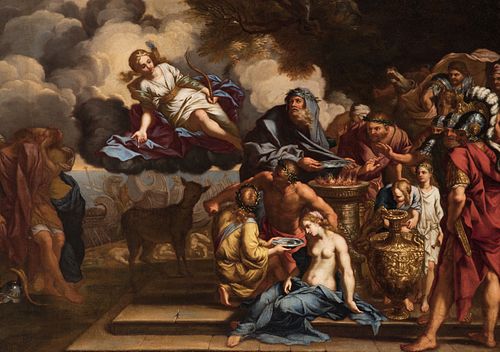French school Possible circle of CHARLES LE BRUN (Paris, 1619-1690); end of the 17th century. "Artemis in the Trojan War". Oil on canvas. Relined.
Lot 46
About Seller
Setdart Auction House
Carrer Aragó 346
Barcelona
Spain
Setdart Subastas was born in 2004 and is currently the first online art auction in Spain with solidity, prestige and reliability guaranteed by our more than 60,000 users. Setdart has a young, dynamic and enterprising team ready to successfully manage the purchase and sale of art works through custom...Read more
Estimate:
EUR€5,000 - EUR€6,000
$5,376.34 - $6,451.61
Absentee vs Live bid
Two ways to bid:
- Leave a max absentee bid and the platform will bid on your behalf up to your maximum bid during the live auction.
- Bid live during the auction and your bids will be submitted real-time to the auctioneer.
Bid Increments
| Price | Bid Increment |
|---|---|
| EUR€0 | EUR€10 |
| EUR€200 | EUR€25 |
| EUR€500 | EUR€50 |
| EUR€1,000 | EUR€100 |
| EUR€3,000 | EUR€200 |
| EUR€5,000 | EUR€500 |
| EUR€10,000 | EUR€1,000 |
| EUR€20,000 | EUR€2,000 |
| EUR€50,000 | EUR€5,000 |
About Auction
By Setdart Auction House
Nov 3, 2021
Set Reminder
2021-11-03 08:00:00
2021-11-03 08:00:00
America/New_York
Bidsquare
Bidsquare : OLD MASTERS
https://www.bidsquare.com/auctions/setdart-auction-house/old-masters-7786
Setdart Auction House sofia@setdart.com
Setdart Auction House sofia@setdart.com
- Lot Description
French school Possible circle of CHARLES LE BRUN (Paris, 1619-1690); end of the 17th century. "Artemis in the Trojan War". Oil on canvas. Relined. Measurements: 98 x 139 cm; 116 x 158 cm (frame). In this scene of mythological theme the author uses a simple composition by locating all the characters in the foreground. This characteristic makes it easier for the viewer to apprehend the scene with greater clarity. In this group of characters several simultaneous scenes can be appreciated, on the left a couple seems to lament, while on the right a group of soldiers and civilians gather around a seated woman to whom she brings a plate. In the center of the scene, in a superior and privileged place is Artemis, or Diana, with her crescent moon on her forehead, her characteristic arrows and under her feet a small fawn. It is probable that this is an image representing the intervention of the goddess in the Trojan War. The role of Artemis during the war was fundamental, as sister of Apollo, she defended the city of Troy. King Agamemnon aroused the wrath of Artemis by boasting of being a better hunter than the goddess, in addition to sacrificing a deer in a sacred area. It was Calchas who suggested to Agamemnon that the only way to regain the favor of the Goddess was the sacrifice of Iphigenia, his daughter. Finally, Artemis deposited a calf on the altar of Iphigenia and took her as priestess. The work is based on an engraving by Pietro Testa, and in turn on an original painting by Andres Rossi. The technical characteristics bring this work close to the production of Charles Le Brun, who was a French painter and important art theorist. He trained in the workshop of Simon Vouet as a child, receiving commissions from Cardinal Richeliu at the age of fifteen. Between 1642 and 1646 he was in Rome, where he came into contact with works by Raphael, Guido Reni, the Bolognese school, etc., and where he was also a disciple of Poussin. He returned to Paris, and continued with an important work, reaching his stylistic maturity towards the middle of the century (classicist and elegant painting). He was ennobled by Louis XIV, who named him Premier Peintre du Roi in 1664. His work is preserved in the Louvre Museum in Paris, in Versailles, in the Los Angeles County Museum of Art, The J. Paul Getty Museum (Los Angeles, United States), the Metropolitan Museum in New York, the Museum of Fine Arts in Lyon (France), the Hermitage in St. Petersburg (Russia), the National Gallery of Art in Washington D.C. (United States), the Rijksmuseum in Amsterdam, etc.
- Shipping Info
-
In-house shipping available. Please inquire at admin@setdart.com.
-
- Buyer's Premium



 EUR
EUR CAD
CAD AUD
AUD GBP
GBP MXN
MXN HKD
HKD CNY
CNY MYR
MYR SEK
SEK SGD
SGD CHF
CHF THB
THB

















